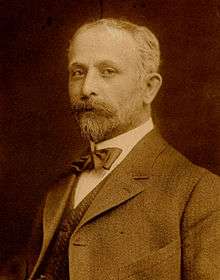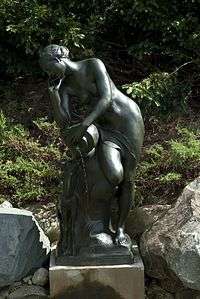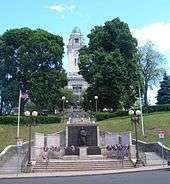Isidore Konti

Isidore Konti (July 9, 1862 – January 11, 1938) was a Vienna-born (of Hungarian parents) sculptor. He began formal art studies at the age of 16 when he entered the Imperial Academy in Vienna, where he studied under Edmund von Hellmer.[1] In 1886 he won a scholarship that allowed him to study in Rome for two years. While there he developed a love of Renaissance art that was to affect the nature of his mature sculpture. Upon returning to Austria, Konti worked as an architectural modeler.
In 1890, 1891 or 1892 (depending on the source) Konti moved, permanently as it turned out, to America, there going straight to Chicago, where he began working on sculptural decorations for the 1893 World's Columbian Exposition.[1][2][3] When the work there was completed, he moved to New York City and commenced working as an assistant for fellow Austrian expatriate Karl Bitter.[3] Konti's skills as a modeler kept him in much demand—for the 1900 Pan American Exposition in Buffalo, New York; for the 1904 Louisiana Purchase Exposition in St. Louis; and for the 1915 Panama Pacific Exposition in San Francisco.[1] In 1906 he was elected into the National Academy of Design as an Associate member and became a full Academician in 1909.
Konti died in Yonkers, New York on January 11, 1938.
Architectural sculpture
Like many sculptor of that epoch Konti created architectural sculpture. His works in this arena include:
- Tympanum, Grace Chapel, New York City 1894.
- Spandrel figures, the Elbridge Gerry House, New York City, 1895.
- Three Graces (for which Audrey Munson served as the model) Hotel Astor, New York City, 1907.
- Frieze: “A Festival Procession of the Arts,” Gainsborough Studio Building, 222 Central Park South, New York City, 1908.
- Statues of Justinian and Alfred the Great, Cuyahoga County Courthouse, Cleveland, Ohio, 1910.
- Twelve statues: Herbert Adams, Daniel Chester French, and Herman Matzen each modeled two of the others. Karl Bitter modeled four of them.
- Capitals, panels and allegorical figures for the Pan-American Building, Washington D.C. 1910.
- Home Life Insurance Building
Public monuments and fountains
- McKinley Memorial, Yonkers, New York 1906
- Mother & Child: the Bath, fountain in Katonah, New York, c. 1910
- recumbent figure of Morgan Dix, Trinity Church, New York, 1915
- The Meeting of Air and Water, Gumbel Memorial Fountain, Audubon Park, New Orleans, Louisiana, 1919.
- A bequest from Sarah Lavinia Hyams funded two identical fountains, with sculpture groups and wading pools:
- Hyams Memorial Fountain, Audubon Park, New Orleans, Louisiana, 1921.
- Hyams Memorial Fountain, City Park, New Orleans, Louisiana, 1921.
- Sarcophagus for Bishop Horatio Potter, Cathedral of Saint John the Divine, New York City, 1921.[4]
- Yonkers World War I Memorial, Yonkers, NY, 1922.
- Edgar John Lownes Memorial, Swan Point Cemetery, Rhode Island, 1924
- Hudson - Fulton Monument, Yonkers, New York, 1924
- Spanish - American War Memorial, Yonkers, New York, 1928
- Lincoln Monument, Lincoln Park, Yonkers, New York, 1929
- Father Kelehan Memorial, St. Joseph's Cemetery, Yonkers, New York, 1929
- Governor Francis T. Nicholls, State Capitol Building, Baton Rouge, Louisiana 1931
Besides these works Isidore Konti produced numerous medals, plaques, figures and figurines that are today highly sought after by museums and collectors.
 William McKinley (1908), City Hall, Philadelphia, Pennsylvania.
William McKinley (1908), City Hall, Philadelphia, Pennsylvania. South American Condor (1910), Pan-American Building, Washington, D.C.
South American Condor (1910), Pan-American Building, Washington, D.C. Meeting of Bolivar and San Martin (1910), Pan-American Building, Washington, D.C
Meeting of Bolivar and San Martin (1910), Pan-American Building, Washington, D.C Mother and Child: the Bath (c. 1910), Katonah, New York.
Mother and Child: the Bath (c. 1910), Katonah, New York. Nymph and Fawn (1917), Indianapolis Museum of Art.
Nymph and Fawn (1917), Indianapolis Museum of Art.- Gumbel Memorial Fountain (1919), Audubon Park, New Orleans, Louisiana.
- Hyams Memorial Fountain (1921), Audubon Park, New Orleans, Louisiana.
 Hyams Memorial Fountain (1921), City Park, New Orleans, Louisiana
Hyams Memorial Fountain (1921), City Park, New Orleans, Louisiana World War I Memorial (1922), City Hall, Yonkers, New York.
World War I Memorial (1922), City Hall, Yonkers, New York. Detail of the columns of progress at the Panama Exposition (1915), San Francisco, California
Detail of the columns of progress at the Panama Exposition (1915), San Francisco, California
References
- 1 2 3 Collecting Sculpture. Fall 2001. New York: John Graham & Sons, Inc., 2001. 17.
- ↑ Duncan, Alice Levi. Paul Manship and His Circle. New York: Gerald Peters Gallery, Inc., 2006. 7.
- 1 2 Grubb, Nancy, and Carol A. McKeown. Paul Manship. New York: Cross River Press, Ltd., 1989. 22.
- ↑ Bishop Potter sarcophagus, from Deposit Photos.
| Wikimedia Commons has media related to Isidore Konti. |
- Craven, Wayne, Sculpture in America, Thomas Y. Crowell Co, NY, NY 1968
- Kvaran, Einar Einarsson, Architectural Sculpture in America unpublished manuscript
- Madigan, Mary Jean Smith, The Sculpture of Isidore Konti: 1862 - 1938, The Hudson River Museum, Yonkers, NY 1974
- National Sculpture Society, Exhibition of American Sculpture Catalogue, 1923, National Sculpture Society, New York 1923
- Opitz, Glenn B, Editor, Mantle Fielding’s Dictionary of American Painters, Sculptors & Engravers, Apollo Book, Poughkeepsie NY, 1986
- Proske, Beatrice Gilman, Brookgreen Gardens Sculpture, Brookgreen Gardens, South Carolina, 1968
- Taft, Lorado, The History of American Sculpture, MacMillan Co., New York, NY 1925